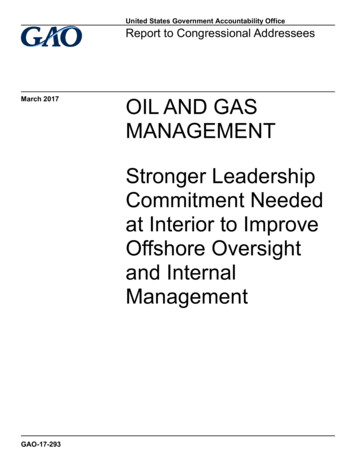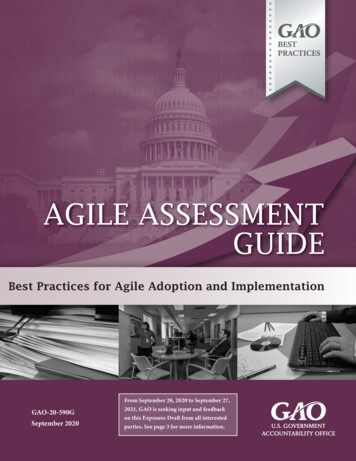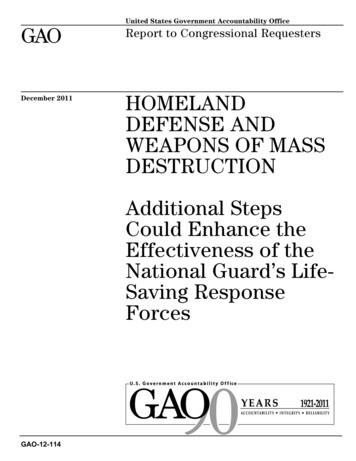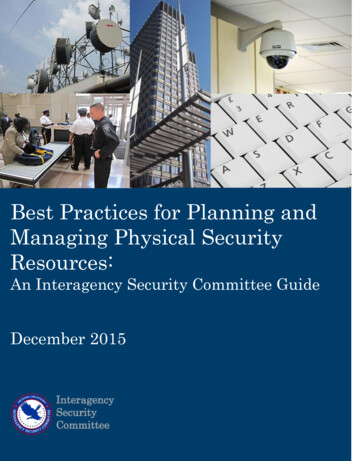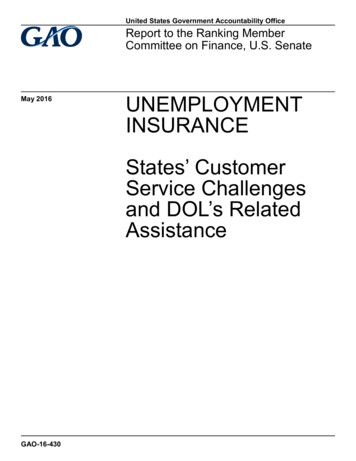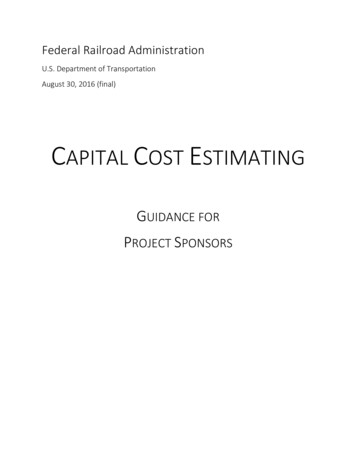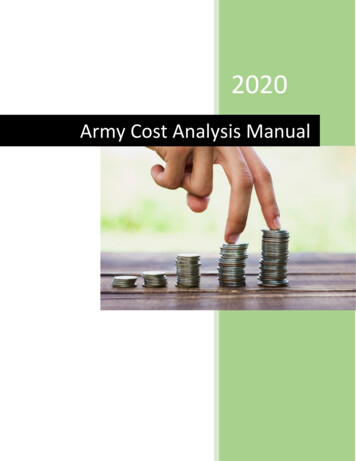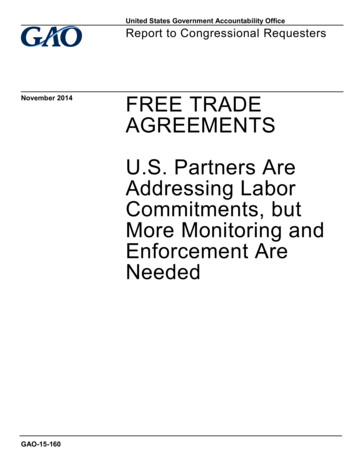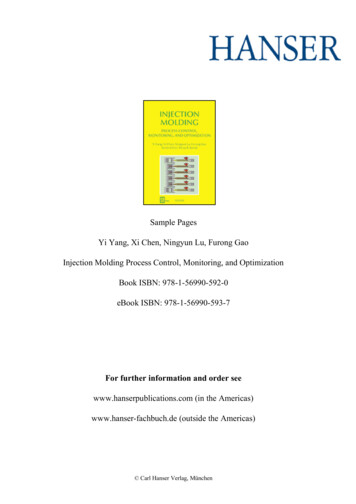
Transcription
United States Government Accountability OfficeOffice of the General CounselPRINCIPLES OFFEDERALAPPROPRIATIONSLAWChapter 1IntroductionFourth Edition2016 RevisionThis document, in conjunction with GAO, Principles of FederalAppropriations Law, 4th ed., 2016 rev., ch. 2, GAO-16-464SP(Washington, D.C.: Mar. 2016), supersedes chapters 1, 2, and 3 of GAO,Principles of Federal Appropriations Law, 3rd ed., GAO-04-261SP(Washington, D.C.: Jan. 2004). Chapters 4 through 15 of the third editionof Principles of Federal Appropriations Law, in conjunction with GAO,Principles of Federal Appropriations Law: Annual Update to the ThirdEdition, GAO-15-303SP (Washington, D.C.: Mar. 2015), remain the mostcurrently available material on the topics discussed therein. BothPrinciples and the Annual Update to the Third Edition are available 3SP
Page iGAO-16-463SP
ContentsPrefaceChapter 11-1Introduction1-4A. Congress and the Constitutional Power of the Purse1-4B. The Role of GAO and its Predecessors1-91. Accounting Officers Prior to 19211-9a. Prior to 18941-10b. 1894 – 1921: Comptroller of the Treasury1-112. GAO’s Authority to Settle Accounts and Issue Decisions1-12a. Procedures1-13b. Matters Not Considered1-153. Program Evaluations and Financial Audits, Investigations, andAccount Settlement1-174. Publication of Decisions1-195. Other GAO Publications1-206. Standard Budgetary Terms1-227. Informal Technical Assistance1-22C. An Analytical Framework1-23D. Statutory Interpretation: Determining Congressional Intent1-241. The Goal of Statutory Construction1-242. The “Plain Meaning” Rule1-273. The Limits of Literalism: Errors in Statutes and “AbsurdConsequences”1-29a. Errors in Statutes1-29b. Avoiding “Absurd Consequences”1-314. Statutory Aids to Construction1-34a. Definitions, Effective Dates, and Severability Clauses1-34b. The Dictionary Act1-34c. Effect of Codification1-355. Canons of Statutory Construction1-36a. Construe the Statute as a Whole1-37b. Give Effect to All the Language: No “Surplusage”1-39c. Apply the Common Meaning of Words1-40d. Give a Common Construction to the Same or SimilarWords1-41e. Punctuation, Grammar, Titles, and Preambles Are Relevantbut Not Controlling1-44f. Avoid Constructions That Pose Constitutional Problems 1-476. Legislative History1-48a. Uses and Limitations1-48b. Components and Their Relative Weight1-50c. Post-enactment Statements1-55Page iGAO-16-463SP
d. Development of the Statutory Language7. Presumptions and “Clear Statement” Rulesa. Presumption in Favor of Judicial Reviewb. Presumption against Retroactivityc. Federalism Presumptionsd. Presumption against Waiver of Sovereign Immunity8. Resolving Conflicts Between Statutesa. Harmonize different statutesb. More specific enactments control over more generalenactmentsc. Enactments later in time supersede earlier onesE. Agency Administrative Interpretations1. Interpretation of Statutes2. Interpretation of Agency’s Own 51-661-661-72This is a work of the U.S. government and is not subject to copyright protection in theUnited States. The published product may be reproduced and distributed in its entiretywithout further permission from GAO. However, because this work may containcopyrighted images or other material, permission from the copyright holder may benecessary if you wish to reproduce this material separately.Page iiGAO-16-463SP
PrefacePrefaceWe are pleased to present the first two chapters of the fourth edition ofPrinciples of Federal Appropriations Law, commonly known as the “RedBook.” Our objective in this publication is to present a basic referencework covering the legal issues that arise as the Comptroller Generalcarries out his statutory duties to issue decisions and opinions concerningthe use and obligation of appropriated funds.Our approach in Principles is to lay a foundation with text discussion,using specific legal authorities to illustrate the principles discussed, theirapplication, and exceptions. These authorities include GAO decisionsand opinions, judicial decisions, statutory provisions, and other relevantsources. We encourage users to begin with Chapter 1, which provides ageneral framework and context for all that follows. Chapter 1 includes asection regarding citations to GAO case law and other relevant GAOmaterial and an explanation of those other materials.We have tried to be simultaneously basic and detailed—basic so that thepublication will be useful as a “teaching manual” and guide for the noviceor occasional user (lawyer and nonlawyer alike) and detailed so that it willassist those requiring a more in-depth understanding. The purpose ofPrinciples is to describe existing authorities; it should not be regarded asan independent source of legal authority. The material in this publicationis, of course, subject to changes in statute or federal and ComptrollerGeneral case law. Also, it is manifestly impossible to cover in thispublication every aspect and nuance of federal appropriations law. Wehave not attempted to include all relevant decisions, and we admit (albeitgrudgingly) that errors and omissions probably are inevitable. Principlesshould therefore be used as a general guide and starting point, not as asubstitute for original legal research.It is also important to emphasize that we have focused our attention onissues and principles of government-wide application. In variousinstances, agency-specific legislation may provide authority or restrictionssomewhat different from the general rule. While we have noted many ofthese instances for purposes of illustration, a comprehensive cataloguingof such legislation is beyond the scope of this publication. Thus, failure tonote agency-specific exceptions in a given context does not mean thatthey do not exist.Page 1-1GAO-16-463SP
PrefaceUnlike the previous three editions of Principles, we will publish eachchapter of the fourth edition upon completion, but we will not assemblethe chapters into volumes. In addition, we will revise fourth editionchapters annually to incorporate new Comptroller General case law aswell as discussions of particularly prominent decisions from the courts.These changes will allow us to maintain the currency of the material inPrinciples without the publication of a separate annual update. Newfourth edition chapters will supersede the corresponding chapters in thethird edition. Third edition chapters that have not been supersededremain the most current work on their respective subjects, when used inconjunction with the 2015 annual update. We will no longer publishannual updates for any of the chapters of the third edition.Chapters 1 and 2 of the fourth edition now include most of the materialfrom chapter 3 of the third edition. Since chapter 3 of the third editionwas consolidated into chapters 1 and 2 of the fourth edition, chapter 3 ofthe fourth edition, when issued, will be titled Availability of Appropriations:Purpose and will correspond to chapter 4 of the third edition.Occasionally, text in the fourth edition includes cross references tochapters that we have not yet updated for the fourth edition. For the timebeing, these cross references continue to refer to the third editionchapters and to the chapter numbers as they appeared in the thirdedition. As we update subsequent chapters for the fourth edition, we willalso update corresponding cross references in earlier fourth editionchapters.In a bow to the times and the electronic world, the fourth edition will bepublished exclusively in electronic form, but readers may easily print eachchapter if desired. All new chapters of the Principles, along withadditional information regarding changes in our publication process forthe fourth edition are available on our website. Please visitwww.gao.gov/legal/ for a link to our Red Book webpage.The response to Principles has been both gratifying and encouragingsince the first edition was published in 1982. We express ourappreciation to the many persons in all branches of the federalgovernment, as well as nonfederal readers, who have offered commentsand suggestions. Our goal now, as it was in 1982, is to present adocument that will serve as a helpful reference for a wide range of users.Page 1-2GAO-16-463SP
PrefaceTo that end, we again invite comments and suggestions for improvement.We thank our readers for their support and hope that this publicationcontinues to serve their needs.Susan A. PolingGeneral CounselMarch 2016Page 1-3GAO-16-463SP
Chapter 1: IntroductionChapter 1: IntroductionA. Congress and theConstitutional Powerof the Purse“Money is, with propriety, considered as the vital principle of the body politic; asthat which sustains its life and motion, and enables it to perform its mostessential functions.”The Federalist No. 30 (Alexander Hamilton).A necessary corollary of Hamilton’s thesis is that the body that controlsthe government’s money also wields great power to shape and control thegovernment itself by determining, for example, the purpose for whichgovernment may use money or the amounts that are available for itsendeavors.Through the Constitution, the framers provided that the legislativebranch—the Congress—has power to control the government’s pursestrings. 1 As James Madison explained, the framers vested Congresswith the power of the purse for two primary reasons. The Federalist No.58 (James Madison). First, this arrangement ensured that thegovernment remained directly accountable to the will of the people:“power over the purse may, in fact, be regarded as the most completeand effectual weapon with which any constitution can arm the immediaterepresentatives of the people, for obtaining a redress of every grievance,and for carrying into effect every just and salutary measure.” Id. Second,Congress through its power of the purse holds a key check on the powerof the other branches, allowing it to reduce “all the overgrownprerogatives of the other branches of government.” Id. Indeed, a later1Many articles describe and analyze substantive aspects of the congressional power ofthe purse. See, e.g., Jack M. Beermann, Congressional Administration, 43 San Diego L.Rev. 61, 84–85 (2006); Sen. Robert C. Byrd, The Control of the Purse and the Line ItemVeto Act, 35 Harv. J. on Legis. 297 (1998); Col. Richard D. Rosen, Funding “NonTraditional” Military Operations: The Alluring Myth of a Presidential Power of the Purse,155 Mil. L. Rev. 1 (1998); Charles Tiefer, Controlling Federal Agencies by Claims on TheirAppropriations? The Takings Bill and the Power of the Purse, 13 Yale J. on Reg. 501(1996); Kate Stith, Congress’ Power of the Purse, 97 Yale L.J. 1343 (1988).Page 1-4GAO-16-463SP
Chapter 1: Introductionobserver described the power of the purse as “the most important singlecurb in the Constitution on Presidential power.” 2The framers vested Congress with the power of the purse by providing inthe Constitution that “no Money shall be drawn from the Treasury, but inConsequence of Appropriations made by Law.” 3 U.S. Const., art. I, § 9,cl. 7. Time and again, the Supreme Court has reaffirmed that this clausemeans exactly what its straightforward language suggests: “no moneycan be paid out of the Treasury unless it has been appropriated by an actof Congress.” 4 Cincinnati Soap Co. v. United States, 301 U.S. 308, 321(1937). This principle, when stated differently, reveals a tenet that is ofcritical importance to every agency, every officer, every employee of thefederal government:“The established rule is that the expenditure of public funds is proper only whenauthorized by Congress, not that public funds may be expended unlessprohibited by Congress.”2thEdward S. Corwin, The Constitution and What It Means Today, 134 (14 ed. 1978) (“[A]President cannot do very much without funds.”). One case illustrates this principle well.Retired military personnel sued the government for breach of an implied-in-fact contract,claiming that recruiters had promised free lifetime medical care for them and theirdependents in exchange for 20 years of service. Schism v. United States, 316 F.3d 1259,1288 (Fed. Cir. 2002), cert. denied, 539 U.S. 910, 123 S. Ct. 2246 (2003). The courtrejected those claims, observing:“As Commander-in-Chief, the President does not have the constitutional authority to makepromises about entitlements for life to military personnel that bind the governmentbecause such powers would encroach on Congress’ constitutional prerogative toappropriate funding. Under Article I, § 8, only Congress has the power of the purse. Tosay that the Executive Branch could promise future funds for activities that Congress itselfhad not authorized . . . would allow the Executive Branch to commandeer the power of theLegislative Branch.”3Other provisions in the Constitution also reflect the framers’ determination to vestCongress with the power of the purse: Congress may, for example, lay and collect taxesand pay debts (art. I, § 8, cl. 1); borrow money (art. I, § 8, cl. 2); and coin money andregulate its value (art. I, § 8, cl. 5).4See also Reeside v. Walker, 52 U.S. (11 How.) 272, 291 (1850) (“However much moneymay be in the Treasury at any one time, not a dollar of it can be used in the payment ofanything not . . . previously sanctioned [by a congressional appropriation].”); Office ofPersonnel Management v. Richmond, 496 U.S. 414, 425 (1990) (any exercise of power bya government agency “is limited by a valid reservation of congressional control over fundsin the Treasury”); B-300192, Nov. 13, 2002 (“[T]he Constitution grants to the Congress thepower to appropriate the resources of the government.”).Page 1-5GAO-16-463SP
Chapter 1: IntroductionUnited States v. MacCollom, 426 U.S. 317, 321 (1976). Thisquintessential axiom animates the entire body of appropriations law. AsJames Madison and subsequent constitutional scholars have recognized,the congressional power of the purse is a key element of theconstitutional framework of checks and balances. Accordingly,Congress’s power of the purse does not manifest as a reservation ofcongressional authority to disapprove of federal expenditures. Rather,the Constitution vests in Congress the power and duty to affirmativelyauthorize all expenditures. Regardless of the nature of the payment—asalary, a payment promised under a contract, a payment ordered by acourt—a federal agency may not make such a payment and, indeed, maynot even incur a liability for such a payment, unless Congress has madefunding authority available. 5 Indeed, a federal agency is a creature of lawand can only carry out any of its functions to the extent authorized by law.See, e.g., Atlantic City Electric Co. v. Federal Energy RegulatoryCommission, 295 F.3d 1, 8 (D.C. Cir. 2002). See also B-323449,Aug. 14, 2012; B-288266, Jan. 27, 2003. Therefore, agencies mustoperate not only in accordance with the funding levels Congress haspermitted, but also in accordance with their authorizing statutes.The axiom that obligations and expenditures are permitted only inaccordance with an appropriation made by law is not limited to fundsdrawn from the so-called “general fund” of the Treasury, which is wherethe government deposits the bulk of its tax receipts. Instead, anygovernment obligation or expenditure whatsoever—whether it is derivedfrom the general fund, from fees arising from the government’s businesslike activities, or from any other source—may be made only as authorizedby an appropriation. 6 Some government activities are financed bypermanent appropriations, and some of these derive their funds from feesrather than taxes. Congress need not appropriate funds for theseactivities on an annual basis to ensure their continued operation.5Of course, Congress’s power of the purse is not without limitation. Congress must staywithin constitutional limits when determining the terms and conditions under which anappropriation may be used. For instance, the Supreme Court has overturned variousfunding conditions that violate the First Amendment. We discuss limitations on Congress’sspending power in chapter 2.6There are extraordinary exceptions to this rule, which generally are stated explicitly inlaw. For example, the Office of the Comptroller of the Currency imposes and collectsparticular fees from some financial institutions. By law these amounts are not consideredappropriated funds. B-324857, Aug. 6, 2015. We discuss this issue further in the “WhatConstitutes an Appropriation” subsection in Chapter 2, The Legal Framework.Page 1-6GAO-16-463SP
Chapter 1: IntroductionNevertheless, such activities are financed using appropriated funds, andabsent any statute stating otherwise, such activities are subject to thelimitations imposed by law upon the use of all appropriated amounts. 7Whenever “the Congress specifies the manner in which a Federal entityshall be funded and makes such funds available for obligation andexpenditure, that constitutes an appropriation, whether the language isfound in an appropriation act or in other legislation.” B-193573, Dec. 19,1979.The Constitution does not detail how Congress is to implement itsconstitutional power of the purse, but provides Congress with the powerto enact statutes to protect and exercise this power. U.S. Const., art. I,§ 9, cl. 7 (Congress may make all laws “necessary and proper” forcarrying into effect Congress’s legislative powers). Congress has donethis through, among other ways, the annual budget and appropriationsprocess and through a series of permanent statutes that establishcontrols on the use of appropriated funds. As one court has put it:“[The Appropriations Clause] is not self-defining and Congress has plenarypower to give meaning to the provision. The Congressionally chosen method ofimplementing the requirements of Article I, section 9, clause 7 is to be found invarious statutory provisions.”Harrington v. Bush, 553 F.2d 190, 194–95 (D.C. Cir. 1977) (footnoteomitted). E.g., Walker v. Department of Housing & Urban Development,912 F.2d 819, 829 (5th Cir. 1990). There were few statutory fundingcontrols in the early years of the nation and abuses were commonplace.As early as 1809, one senator, citing a string of abuses, introduced aresolution to look into ways to prevent the improper expenditure of publicfunds. 8 In 1816 and 1817, John C. Calhoun lamented the “great evil” ofdiverting public funds to uses other than those for which they wereappropriated. 9 Executive abuses continued into the post-Civil War years.“Funds were commingled. Obligations were made without appropriations.Unexpended balances from prior years were used to augment currentappropriations.” 107We discuss this issue further in Chapter 2, The Legal Framework.819 Annals of Cong. 347 (1809) (remarks of Senator Hillhouse).9Gary L. Hopkins & Robert M. Nutt, The Anti-Deficiency Act (Revised Statutes 3679) andFunding Federal Contracts: An Analysis, 80 Mil. L. Rev. 51, 57 n.7 (1978).10Id. at 57.Page 1-7GAO-16-463SP
Chapter 1: IntroductionThe permanent fiscal statutes, found mostly in title 31 of the United StatesCode, implement Congress’s power of the purse and are designed tocombat these and other abuses. These statutes form the legal frameworkfor appropriations law. They did not spring up overnight, but haveevolved over the span of more than two centuries. Nevertheless, whenviewed as a whole, they form a logical framework that governs thecollection and use of public money. We may regard them as pieces of apuzzle that fit together to form the larger picture of how Congressexercises its power of the purse. As Hamilton explained, nearly anyaction government takes requires money; therefore, the statutesgoverning the use of public money ultimately affect every governmentactivity, whether monumental or minute. Some of the key statutes in thisscheme, each of which is discussed elsewhere in this publication, are: A statute will not be construed as making an appropriation unless itexpressly so states. 31 U.S.C. § 1301(d). We discuss this provisionin Chapter 2, The Legal Framework. Appropriations may be used only for their intended purposes. 31U.S.C. § 1301(a). This is known as the purpose statute and wediscuss it in Chapter 4, Availability of Appropriations: Purpose. Appropriations made for a definite period of time may be used onlyfor expenses properly incurred during that time. 31 U.S.C. § 1502(a).This is known as the bona fide needs statute and we discuss it inChapter 5, Availability of Appropriations: Time. Time-limited appropriations that are unobligated at the end of theirperiod of availability are said to “expire” and are no longer availablefor new obligations. 31 U.S.C. § 1552. This statute is known as theaccount closing law and it specifies the limited uses for which expiredfunds remain available. We discuss this in Chapter 5, Availability ofAppropriations: Time. Agencies may not spend, or commit themselves to spend, in advanceof or in excess of appropriations. 31 U.S.C. § 1341. This is knownas the Antideficiency Act and we discuss it in Chapter 6, Availabilityof Appropriations: Amount. Unless authorized by law, an agency may not keep money it receivesfrom sources other than appropriations, but must deposit the moneyin the Treasury. 31 U.S.C. § 3302(b). This is known as themiscellaneous receipts statute and we discuss it in Chapter 6,Availability of Appropriations: Amount. All obligations that an agency incurs must be supported bydocumentary evidence and must be properly recorded. 31 U.S.C.Page 1-8GAO-16-463SP
Chapter 1: Introduction§ 1501. This is known as the recording statute and we discuss it inChapter 7, Obligation of Appropriations.This publication discusses the body of decisions and opinions, especiallyfrom the courts and GAO, that interpret and apply these statutes.Collectively, the clauses of the Constitution pertaining to Congress’spower of the purse, the statutes protecting and exercising this power, andthe decisions interpreting this power constitute the body of what is knownas appropriations law. This body of law gives flesh and force to one ofthe key pillars of democracy that the framers incorporated in theConstitution. Appropriations law is not only about ensuring that federalagencies follow a set of rules that Congress has enacted. These lawsalso help ensure that government carries out the will of, and remainsaccountable to, the American people. 11B. The Role of GAOand itsPredecessorsIn furtherance of its constitutional responsibilities to control and overseethe use of public money, Congress has vested GAO with several statutoryfunctions. Because some of these functions were carried out by othergovernment officers before Congress created GAO in 1921, a briefdiscussion of these predecessors to GAO will help illuminate the contoursof GAO’s responsibilities.1. Accounting Officers Priorto 1921Since the early days of the republic, Congress, in exercising its oversightof the public purse, has utilized administrative officials for the settlementof public accounts and the review of federal expenditures.11The second part of article I, section 9, clause 7 of the Constitution underscoresaccountability. It requires that “a regular Statement and Account of the Receipts andExpenditures of all public Money shall be published from time to time.” Implementation ofthis provision, as a logical corollary of the appropriation power, is also wholly within thecongressional province. Washington Post Co. v. United States Department of State, 685F.2d 698, 700 (D.C. Cir. 1982) (“the plenary authority of Congress in this area will berespected”), vacated as moot, 464 U.S. 979 (1983); United States v. Richardson, 418 U.S.166, 178 n.11 (1974) (“it is clear that Congress has plenary power to exact any reportingand accounting it considers appropriate in the public interest”); Harrington v. Bush, 553F.2d at 195; Hart’s Case, 16 Ct. Cl. 459, 484 (1880), aff’d, Hart v. United States, 118 U.S.62 (1886) (“[a]uditing and accounting are but parts of a scheme for payment”). See alsoB-300192, n.10, Nov. 13, 2002.Page 1-9GAO-16-463SP
Chapter 1: Introductiona. Prior to 1894Throughout most of the nineteenth century, the accounting officers 12consisted of a series of comptrollers and auditors. Starting in 1817 withtwo comptrollers and four auditors, the number increased until, for thesecond half of the century, there were three co-equal comptrollers (FirstComptroller, Second Comptroller, Commissioner of Customs) and sixauditors (First Auditor, Second Auditor, etc.), all officials of the TreasuryDepartment. The jurisdiction of the comptrollers and auditors was dividedgenerally along departmental lines, with the auditors examining accountsand submitting their settlements to the appropriate comptroller.The practice of rendering written decisions goes back at least to 1817.However, very little of this material exists in published form. (Untilsometime after the Civil War, the decisions were handwritten.)There are no published decisions of the First Comptroller prior to the termof William Lawrence (1880–85). Lawrence published his decisions in aseries of six annual volumes. After Lawrence’s decisions, a gap of 9years followed until First Comptroller Robert Bowler published a singleunnumbered volume of his 1893–94 decisions. 13The decisions of the Second Comptroller and the Commissioner ofCustoms were never published. However, volumes of digests ofdecisions of the Second Comptroller were published starting in 1852.The first volume, unnumbered, saw three cumulative editions, the latestissued in 1869 and including digests for the period 1817–69. Threeadditional volumes (designated volumes 2, 3, and 4) were published in1884, 1893, and 1899 (the latter being published several years after the12Early decisions often referred to the “accounting officers of the government.” While thisphrase has fallen into disuse, its purpose was to distinguish those matters within thejurisdiction of the Comptroller General and his predecessors from those matters within thejurisdiction of the “law officers of the government”—the Attorney General and theDepartment of Justice.13Citations to these are rarely encountered, and we have observed no consistent citationformat, except that the First Comptroller’s name is always included to prevent confusionwith the later Comptroller of the Treasury series. Example: 5 Lawrence, First Comp. Dec.408 (1884).Page 1-10GAO-16-463SP
Chapter 1: Introductionoffice had ceased to exist), covering respectively, the periods 1869–84,1884–93, and 1893–94. 14Thus, material available in permanent form from this period consists ofLawrence’s six volumes, Bowler’s single volume, and four volumes ofSecond Comptroller digests.b. 1894–1921: Comptroller ofthe TreasuryIn 1894, Congress enacted the so-called Dockery Act, actually a part ofthe general appropriation act for 1895 (ch. 174, 28 Stat. 162, 205(July 31, 1894)), which consolidated the functions of the First and SecondComptrollers and the Commissioner of Customs into the newly createdComptroller of the Treasury. (The title was a reversion to one that hadbeen used before 1817.) The six auditors remained, with different titles,but their settlements no longer had to be automatically submitted to theComptroller.The Dockery Act included a provision requiring the Comptroller of theTreasury to render decisions upon the request of an agency head or adisbursing officer. (Certifying officers did not exist back then.) Althoughthis was to a large extent a codification of existing practice, it gaveincreased significance to the availability of the decisions. Accordingly, thefirst Comptroller of the Treasury (Robert Bowler, who had been FirstComptroller when the Dockery Act passed) initiated the practice ofpublishing an annual volume of decisions “of such general character aswill furnish precedents for the settlements of future accounts.” 1 Comp.Dec. iv (1896) (Preface).The Decisions of the Comptroller of the Treasury series consists of 27volumes covering the period 1894–1921. 15 Comptroller of the Treasurydecisions not included in the annual volumes exist in bound “manuscriptvolumes,” which are now in the custody of the National Archives, and are,thus, unavailable as a practical matter.14Digests are numbered consecutively within each volume. Citations should specify thedigest number rather than the page number since several digests appear on each page.Example: 4 Dig. Second Comp. Dec. ¶ 35 (1893). Without the text of the decisionsthemselves, the digests are primarily of historical interest.15These are cited by volume and page number, respectively, and the year of the decision,using the abbreviation “Comp. Dec.” Example: 19 Comp. Dec. 582 (1913). There is also ahefty (2,497 pages) volume, published in 1920, of digests of decisions appearing involumes 1–26.Page 1-11GAO-16-463SP
Chapter 1: Introduction2. GAO’s Authority to SettleAccounts and IssueDecisionsWhen the Budget and Accounting Act, 1921, created the GeneralAccounting Office, the offices of the Comptroller of the Treasury and thesix Auditors were abolished and their functions transferred to theComptroller General. Among these functions was the issuance of legaldecisions to agency officials concerning the availability and use ofappropriated funds. Thus, the decisions GAO issues today reflect thecontinuing evolution of a body of administrative law on federal fiscalmatters dating back to the Nation’s infancy.Under the Budget and Accounting Act, the Comptroller General “shallsettle all accounts of the United States Government.” 31 U.S.C.§ 3526(a). Often the term “settle” means “compromise,” particularly whenused in a litigious context. Here, however, “settle” means anadministrative determination of the state of the account and the finalamount due. Illinois Surety Co. v. United States ex rel. Peeler, 240 U.S.214, 219-221 (1916). Accountable officers bear personal pecuniaryliability for the loss of funds in thei
third edition. Third edition chapters that have not been superseded remain the most current work on their respective subjects, when used in conjunction with the 2015 annual update. We will no longer publish annual updates for any of the chapters of the third edition. Chapters 1 and 2 of the fourth


